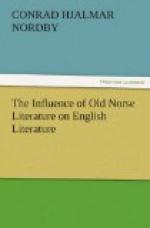Our interest in Gray’s Romanticism must confine itself to the two odes from the Old Norse. It is to be noted that the first transplanting to English poetry of Old Norse song came about through the scholar’s agency, not the poet’s. It was Gray, the scholar, that made “The Descent of Odin” and “The Fatal Sisters.” They were intended to serve as specimens of a forgotten literature in a history of English poetry. In the “Advertisement” to “The Fatal Sisters” he tells how he came to give up the plan: “The Author has long since drop’d his design, especially after he heard, that it was already in the hands of a Person well qualified to do it justice, both by his taste, and his researches into antiquity.” Thomas Warton’s History of English Poetry was the execution of this design, but in that book no place was found for these poems.
In his absurd Life of Gray, Dr. Johnson said: “His translations of Northern and Welsh Poetry deserve praise: the imagery is preserved, perhaps often improved, but the language is unlike the language of other poets.” There are more correct statements in this sentence, perhaps, than in any other in the essay, but this is because ignorance sometimes hits the truth. It is not likely that the poems would have been understood without the preface and the explanatory notes, and these, in a measure, made the reader interested in the literature from which they were drawn. Gray called the pieces “dreadful songs,” and so in very truth they are. Strength is the dominant note, rude, barbaric strength, and only the art of Gray saved it from condemnation. To-day, with so many imitations from Old Norse to draw upon, we cannot point to a single poem which preserves spirit and form as well as those of Gray. Take the stanza:
Horror covers all the heath,
Clouds of carnage
blot the sun,
Sisters, weave the web of
death;
Sisters, cease,
the work is done.
The strophe is perfect in every detail. Short lines, each ending a sentence; alliteration; words that echo the sense, and just four strokes to paint a picture which has an atmosphere that whisks you into its own world incontinently. It is no wonder that writers of later days who have tried similar imitations ascribe to Thomas Gray the mastership.
That this poet of the eighteenth century, who “equally despised what was Greek and what was Gothic,” should have entered so fully into the spirit and letter of Old Norse poetry is little short of marvelous. If Professor G.L. Kittredge had not gone so minutely into the question of Gray’s knowledge of Old Norse,[3] we might be pardoned for still believing with Gosse[4] that the poet learned Icelandic in his later life. Even after reading Professor Kittredge’s essay, we cannot understand how Gray could catch the metrical lilt of the Old Norse with only a Latin version to transliterate the parallel Icelandic. We suspect that Gray’s knowledge was fuller than Professor Kittredge will allow, although we must admit that superficial knowledge may coexist with a fine interpretative spirit. Matthew Arnold’s knowledge of Celtic literature was meagre, yet he wrote memorably and beautifully on that subject, as Celts themselves will acknowledge.[5]




